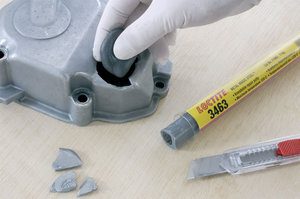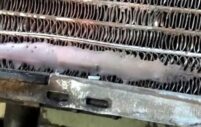
How to use cold welding for metal
Content
Cold welding for metal is a high-strength adhesive that allows you to quickly solve the problem caused by mechanical damage to metal products for a short time.

It is also applicable for minor repairs of metal structures, inside which there is liquid under low pressure - plumbing pipes and various radiators. This latter property has made cold welding an extremely popular tool, due to its ability to glue metal "wet", squeezing out the liquid during the solidification process.
Cold welding consists of 4 main components:
- epoxy resin;
- hardener;
- metal powder;
- additives in the form of sulfur or other substances.
Types of cold welding for metal
By composition, two types of glue are distinguished:
- one-component. The curing process starts at the moment of opening the package, when moisture from the air gets into it. Therefore, such glue is used all at once;
- two-component. It consists of epoxy resin mixed with metal powder and a hardener. For its solidification, it is necessary to mix the components thoroughly. Available in liquid and plastic-like consistencies. Liquid glue is used when it is necessary to seal pipes or repair cracks. Plasticine is suitable when you need to restore and connect broken structural elements. With ductile cold welding, you can even repair the thread on a bolt by applying glue and threading it with a nut until the glue hardens.

According to the scope of application, glue can be divided into several types:
- Universal... Its components are selected so that you can glue not only metal, but also a lot of other materials. However, the result of such a repair leaves much to be desired.
- Special... Designed for bonding a specific material. In addition, it contains substances that impart important properties to the compound, for example, moisture resistance or heat resistance.
- Автомобильный... Its composition is thought out in such a way that it is possible to repair metal, rubber, plastic and glass car parts. At its core, it is universal, but due to its "focus" on a relatively small range of materials, it is much stronger than the usual universal.

What cold welding is suitable for a car radiator
Cold welding should be kept in the arsenal of any car enthusiast who started a long trip, because it can come to the rescue in the event of a radiator leak. Here, both plastic-like and liquid form of cold welding can be useful. Car owners often use plastic glue, but if there is a need for higher strength, it is better to use liquid glue.
As for the narrower specialization of glue, then you can pay attention to a special heat-resistant glue for metal with aluminum dust (for aluminum radiators) or car glue.
Cold Welding Car Radiator Welding Process

In order to restore the operability of the leaked radiator for some time, you need to take the following steps:
- Treat the leak with sandpaper, preferably until shine appears. It is important to leave deep scratches on the metal in order to increase the contact area with the adhesive.
- Degrease the metal with acetone, and if not, use gasoline.
- Squeeze out the required amount of cold welding from the tube or separate from the bar, then bring it to a "working" state by stirring or kneading until a homogeneous consistency is obtained.
- Apply the composition to the leak and level. This should be done as quickly as possible, as depending on the type of glue, it can set quite quickly. If the hole is large, then it is better to close it up using a piece of tin as a patch and glue it with the same glue.
- After repairing the damaged area, you need to allow the glue to completely harden. This will take from 1 hour to XNUMX hours depending on the thickness of the layer, the manufacturer of the adhesive and the ambient temperature. If time is running out, then in half an hour you can start the car and go to the nearest service.
The result of using cold welding to repair a car radiator can be different and depends on many factors. This is the presence of coolant under the place where the damage was sealed, and the size of the damaged area, and the thickness of the adhesive layer, and the time it was given to dry. In the best case, you can even drive several hundred kilometers without any problems. Keep in mind, however, that cold welding is only a temporary measure and you should always be on the lookout.
Questions and answers:
What can be cold welded? According to the manufacturers of such products, their products are capable of gluing almost any surface: metal, glass, wood, ceramic, rubber and even stone.
How long does cold weld last? It depends on the type of surface to be glued, adherence to the gluing technique, and the operating conditions of the finished product. The composite material dries up in approximately 8 hours.
